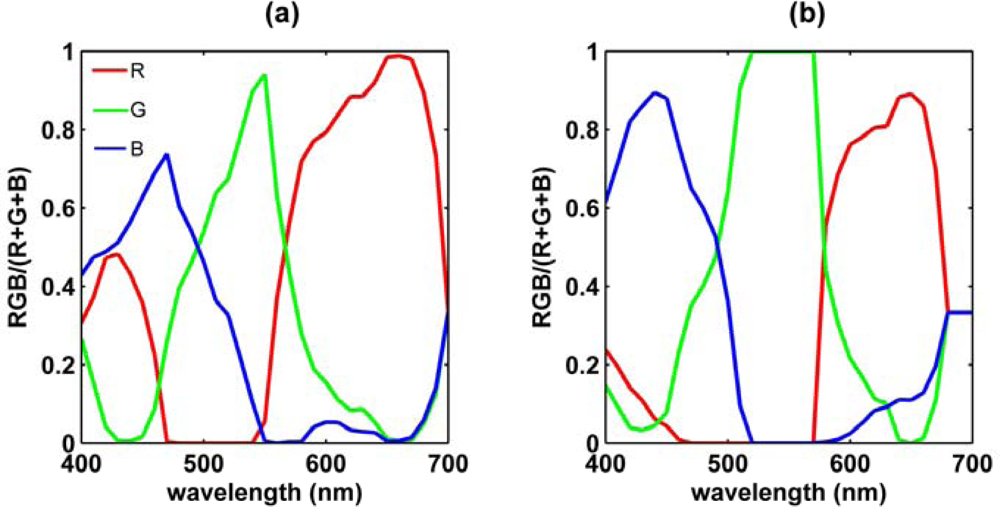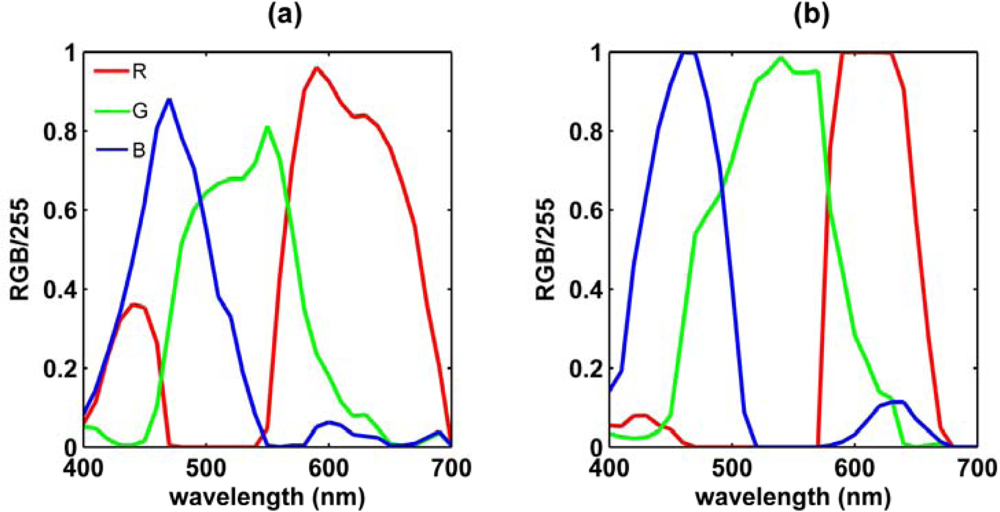Fundamentals of in Situ Digital Camera Methodology for Water Quality Monitoring of Coast and Ocean
Abstract
:1. Introduction
2. Methods
2.1. Image Acquisition
2.2. Response Spectra of the Cameras
2.3. In Situ Measurements Using the Ocean Colour Sensor
2.4. The Colour of Underwater Down Welling Daylight
2.5. Field Surveys
3. Results
3.1. Response Spectra
3.2. In Situ Comparison between the Digital Camera and the Ocean Colour Sensor
3.3. Relationships between RGB Ratios and Water Quality Parameters
3.4. Variation in down Welling Daylight
3.5. In Situ Comparison between the Cameras
4. Discussion
5. Conclusions
Acknowledgments
References and Notes
- Morel, Y.A.; Prieur, L. Analysis of variations in ocean color. Limnol. Oceanogr 1977, 22, 709–722. [Google Scholar]
- Gordon, H.R.; Brown, O.B.; Evans, R.H.; Brown, J.W.; Smith, R.C.; Baker, K.S.; Clark, D.K. A semianalytic radiance model of ocean color. J. Geophys. Res 1988, 93, 10909–10924. [Google Scholar]
- Carder, K.L.; Hawes, S.K.; Baker, K.A.; Smith, R.C.; Steward, R.G.; Mitchell, B.G. Reflectance model for quantifying chlorophyll a in the presence of productivity degradation products. J. Geophys. Res 1991, 96, 20599–20611. [Google Scholar]
- Aiken, J.; Moore, G.F.; Holligan, P.M. Remote sensing of oceanic biology in relation to global climate change. J. Phycol 1992, 28, 579–590. [Google Scholar]
- O'Reilly, J.E.; Maritorena, S.B.; Mitchell, G.; Siegel, D.A.; Carder, K.L.; Garver, S.A.; Kahru, M; McClain, C. Ocean color chlorophyll algorithms for SeaWiFS. J. Geophys. Res 1998, 103, 24937–24953. [Google Scholar]
- Bowers, D.G.; Harker, G.E.L.; Stephan, B. Absorption spectra of inorganic particles in the Irish Sea and their relevance to remote sensing chlorophyll. Int. J. Remote Sens 1996, 17, 2449–2460. [Google Scholar]
- Bowers, D.G.; Kratzer, S.; Morrison, J.R.; Smith, P.S.D.; Tett, P.; Walne, A.W.; Wild-Allen, K. On the calibration and use of in situ ocean colour measurements for monitoring algal blooms. Int. J. Remote Sens 2001, 22, 359–368. [Google Scholar]
- Bowers, D.G.; Boudjelas, S.; Harker, G.E.L. The distribution of fine suspended sediments in the surface waters of the Irish Sea and its relation to tidal stirring. Int. J. Remote Sens 1998, 19, 2789–2805. [Google Scholar]
- Bowers, D.G.; Gaffney, S.; White, M.; Bowyer, P. Turbidity in the southern Irish Sea. Cont. Shelf Res 2002, 22, 2115–2126. [Google Scholar]
- Vasilkov, A.P.; Burenkov, V.I.; Ruddick, K.G. The spectral reflectance and transparency of river plume waters. Int. J. Remote Sens 1999, 20, 2497–2508. [Google Scholar]
- Bowers, D.G.; Harker, G.E.L.; Smith, P.S.D.; Tett, P. Optical properties of a region of freshwater influence (the Clyde Sea). Est. Coast. Shelf Sci 2000, 50, 717–726. [Google Scholar]
- Bowers, D.G.; Evans, D.; Thomas, D.N.; Ellis, P.J.; Williams, P.J.B. Interpreting the colour of an estuary. Est. Coast. Shelf Sci 2004, 59, 13–20. [Google Scholar]
- Siddorn, J.R.; Bowers, D.G.; Hoguanes, A.M. Detecting the Zambezi River plume using observed optical properties. Mar. Pollut. Bul 2001, 42, 942–950. [Google Scholar]
- Dean, C.; Warner, T.A.; McGraw, J.B. Suitability of the DSC460c colour digital camera for quantitative remote sensing analysis of vegetation. ISPRS J. Photogramm 2000, 55, 105–108. [Google Scholar]
- Mason, S.; Rüther, H.; Smit, J. Investigation of the Kodak DCS460 digital camera for small-area mapping. ISPRS J. Photogram 1997, 52, 202–214. [Google Scholar]
- Dymond, J.R.; Trotter, C.M. Directional reflectance of vegetation measured by a calibrated digital camera. Appl. Opt 1997, 36, 4314–4319. [Google Scholar]
- Cox, C.; Munk, W. Measurements of the roughness of the sea surface from photographs of the sun's glitter. J. Opt. Soc. Am 1954, 44, 838–850. [Google Scholar]
- Figueiredo da Silva, J.; Duck, R.W.; Anderson, J.M.; McManus, J.; Monk, J.G.C. Airborne observations of frontal systems in the inlet channel of the Ria de Aveiro, Portugal. Phys. Chem. Earth (B) 2001, 26, 713–719. [Google Scholar]
- Dugan, J.P.; Piotrowski, C.C. Surface current measurements using airborne visible time series. Remote Sens. Environ 2003, 84, 309–319. [Google Scholar]
- White, M.; Feighery, L.; Bowers, D.; O'Riain, G.; Bowyer, P. Using a digital camera for river plume and water quality measurements. Int. J. Remote Sens 2005, 26, 4405–4419. [Google Scholar]
- Smith, R.C.; Austin, R.W.; Tyler, J.E. An oceanographic radiance distribution camera system. Appl. Opt 1970, 9, 2015–2022. [Google Scholar]
- Goddijn, L.M.; White, M. Digital camera measurements of water quality parameters in Galway Bay, Ireland. Est. Coast. Shelf Sci 2006, 66, 429–436. [Google Scholar]
- Kirk, J.T.O. Light & Photosynthesis in Aquatic Ecosystems, 2nd ed; Cambridge University Press: Cambridge, UK, 1994; pp. 57–72. [Google Scholar]
- Brown, J.; Simpson, J.H. The radiometric determination of total pigment and seston and its potential use in shelf seas. Est. Coast. Shelf Sci 1990, 31, 1–9. [Google Scholar]
- Manual CP885. The Nikon guide to digital photography with the Coolpix885 digital camera; Nikon: Tokyo, Japan.
- Wernand, M.R. Guidelines for (ship borne) auto-monitoring of coastal and ocean colour. Oceanographic Society. Proceedings of Ocean Optics XVI, Santa-Fe, NM, USA, November 18–22, 2002.
- Austin, R.W. The remote sensing of spectral radiance from below the ocean surface. In Optical Aspects of Oceanography; Jerlov, N.G., Ed.; Academic Press Inc: London, UK, 1974; pp. 317–343. [Google Scholar]
- Jerlov, N.G. Optical Oceanography; Elsevier Publishing Company: Amsterdam, The Netherlands, 1968; pp. 67–73. [Google Scholar]
- Dekker, A.G. Detection of Optical Water Quality Parameters for Eutrophic Waters by High Resolution Remote Sensing, Ph.D. Thesis.. Department of Earth Sciences, Vrije Universiteit, Amsterdam, The Netherlands, 1993; pp. 1–74.
- Goddijn, L.M. Using a Digital Camera for Water Quality Measurements in Galway Bay, Ph.D. Thesis.. Department of Earth and Ocean Sciences, NUIG, Galway, Ireland, 2007; p. 97.
- Parsons, T.R.; Maita, Y.; Lalli, C.M. A Manual of Chemical and Biological Method for Seawater Analysis; Pergamon Press: New York, NY, USA, 1984. [Google Scholar]
- Boynton, R.M. History and current status of a physiologically based system of photometry and colorimetry. J. Opt. Soc. Am. (A) 1996, 13, 1609–1621. [Google Scholar]
- Goddijn, L.M. Using a Digital Camera for Water Quality Measurements in Galway Bay, Ph.D. Thesis.. Department of Earth and Ocean Sciences, NUIG, Galway, Ireland, 2007; p. 236.
- Kirk, J.T.O. Light & Photosynthesis in Aquatic Ecosystems, 2nd ed; Cambridge University Press: Cambridge, UK, 1994; pp. 1–130. [Google Scholar]
- Wilson, F.A. An Introduction to Light in Electronics; Bernard Babani (publishing) LTD: London, UK, 1994. [Google Scholar]
- Goddijn, L.M. Using a Digital Camera for Water Quality Measurements in Galway Bay, Ph.D. Thesis.. Department of Earth and Ocean Sciences, NUIG, Galway, Ireland, 2007; p. 159.
- GES-DISC DAAC. The images and data used in this study were acquired using the GES-DISC Interactive Online Visualization ANd aNalysis Infrastructure (Giovanni) as part of the NASA's Goddard Earth Sciences (GES) Data and Information Services Center (DISC). 2006. [Google Scholar]
- Kirk, J.T.O. Light & Photosynthesis in Aquatic Ecosystems, 2nd ed; Cambridge University Press: Cambridge, UK, 1994; pp. 1–114. [Google Scholar]
- Mitchelson, E.G.; Jacob, N.J.; Simpson, J.H. Ocean colour algorithms from the Case 2 waters of the Irish Sea in comparison to algorithms from Case 1 waters. Cont. Shelf Res 1986, 5, 403–415. [Google Scholar]
- Gordon, H.R.; Clark, D.K.; Brown, J.W.; Brown, O.B.; Evans, R.H.; Broenkow, W.W. Phytoplankton pigment concentrations in the Middle Atlantic Bight: comparison of ship determinations and CZCS estimates. Appl. Opt 1983, 22, 20–36. [Google Scholar]
- Goddijn, L.M. Using a Digital Camera for Water Quality Measurements in Galway Bay, Ph.D. Thesis.. Department of Earth and Ocean Sciences, NUIG, Galway, Ireland, 2007; p. 167.









| (a) CP885 | (b) ECOshot | ||||||
|---|---|---|---|---|---|---|---|
| i | R/Itot | G/Itot | B/Itot | i | R/Itot | G/Itot | B/Itot |
| λi | 650 | 550 | 470 | λi | 650 | 545 | 440 |
| si | 0.99 | 0.95 | 0.74 | si | 0.89 | 1.00 | 0.89 |
| HBW | 130 | 80 | 125 | HBW | 100 | 90 | 110 |
| (a) CP885 | (b) ECOshot | ||||||
|---|---|---|---|---|---|---|---|
| i | R/255 | G/255 | B/255 | i | R/255 | G/255 | B/255 |
| λi | 590 | 550 | 470 | λi | 600 | 540 | 460 |
| si | 0.96 | 0.81 | 0.88 | si | 1.00 | 1.00 | 1.00 |
| HBW | 110 | 105 | 70 | HBW | 75 | 110 | 75 |
| (a) | |||||
| S | nys | mys | √MSE | P | R2 |
| I | 1.2 | −0.2 | ±0.2 | 0.001 | 0.81 |
| II | 0.8 | 0 | ±0.1 | 0.001 | 0.92 |
| IV | 2.2 | −0.8 | ±0.1 | 0.05 | 0.60 |
| V | 0.7 | −0.1 | ±0.07 | 0.001 | 0.83 |
| VI | 1.3 | −0.4 | ±0.3 | 0.001 | 0.83 |
| VII | 1.7 | −0.6 | ±0.3 | 0.001 | 0.90 |
| All | 1.25 | −0.3 | ±0.2 | 0.001 | 0.82 |
| (b) | |||||
| S | nc | ln(mc) | √MSE | P | R2 |
| I | −4.7 | −1.0 | ±0.4 | 0.001 | 0.80 |
| II | −1.6 | 0 | ±0.4 | 0.001 | 0.80 |
| IV | 3.9 | 2.1 | ±0.3 | 0.2 | 0.20 |
| V | −4.2 | −1.0 | ±0.3 | 0.001 | 0.66 |
| VI | 1.5 | 1.7 | ±0.3 | 0.05 | 0.37 |
| All | −2.6 | −0.4 | ±0.6 | 0.01 | 0.18 |
© 2009 by the authors; licensee MDPI, Basel, Switzerland This article is an open access article distributed under the terms and conditions of the Creative Commons Attribution license (http://creativecommons.org/licenses/by/3.0/).
Share and Cite
Goddijn-Murphy, L.; Dailloux, D.; White, M.; Bowers, D. Fundamentals of in Situ Digital Camera Methodology for Water Quality Monitoring of Coast and Ocean. Sensors 2009, 9, 5825-5843. https://doi.org/10.3390/s90705825
Goddijn-Murphy L, Dailloux D, White M, Bowers D. Fundamentals of in Situ Digital Camera Methodology for Water Quality Monitoring of Coast and Ocean. Sensors. 2009; 9(7):5825-5843. https://doi.org/10.3390/s90705825
Chicago/Turabian StyleGoddijn-Murphy, Lonneke, Damien Dailloux, Martin White, and Dave Bowers. 2009. "Fundamentals of in Situ Digital Camera Methodology for Water Quality Monitoring of Coast and Ocean" Sensors 9, no. 7: 5825-5843. https://doi.org/10.3390/s90705825
APA StyleGoddijn-Murphy, L., Dailloux, D., White, M., & Bowers, D. (2009). Fundamentals of in Situ Digital Camera Methodology for Water Quality Monitoring of Coast and Ocean. Sensors, 9(7), 5825-5843. https://doi.org/10.3390/s90705825





